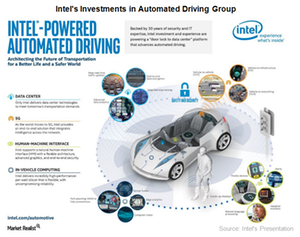Could Intel Make the Mobileye Integration a Success?
Intel is looking to mitigate the integration risk by integrating its Automated Driving Group with Mobileye instead of integrating Mobileye into its business.
March 21 2017, Updated 10:36 a.m. ET

Intel’s integration strategy for Mobileye
Intel’s (INTC) newest competitor is Nvidia (NVDA). Intel has been struggling to catch up with Nvidia on the technology front. The latest move in its catch-up game is the acquisition of Mobileye (MBLY). The success of an acquisition depends on how the business is integrated and what synergies are realized. Intel’s history of failed M&As (mergers and acquisitions) is already haunting the success of the Mobileye merger.
This time, Intel is looking to mitigate the integration risk by integrating its Automated Driving Group with Mobileye instead of integrating Mobileye into its business.
Intel’s other acquisitions in autonomous car technologies 
Intel’s Automated Driving Group is comprised of all the companies in which Intel invested as part of its autonomous driving strategy. Intel Capital has funded the following five start-up companies that deal with autonomous car technologies:
- LISNR: high-frequency data communications and connectivity
- Perrone Robotics: sensors, control systems, and software
- Peloton Technology: automating heavy-duty trucks
- Japan-based ZMP: robotics and sensing technology
- Hong Kong–based Chronocam: machine vision sensors and systems
Apart from the above five companies, Intel has acquired the following three companies in Israel:
- Ginger Software: personal assistant platform
- Omek Interactive: gesture-based technologies
- Replay Technologies: 3D video
How would Intel integrate Mobileye?
The key aspects of an international integration are to decide where operations will be based and how the combined company will function. For instance, Netherlands-based Avago acquired US-based Broadcom (AVGO) and adopted the latter’s name and based the combined company in the United States.
Intel plans to follow a similar strategy. It will base the combined automotive unit in Israel (EIS) and hand over the new unit’s operations to Mobileye’s chief executive officer Amnon Shashua. Since autonomous cars involve various components that are new to Intel, Mobileye’s expertise could come in handy.
How could Intel’s technology benefit Mobileye?
After the merger, Mobileye would have access to Intel’s state-of-the-art fabrication facilities and research labs. Mobileye’s EyeQ processors are currently built on the old RISC (reduced instruction set computing) architecture of MIPS (million instructions per second) developed in the 1980s. The combined unit would scrap MIPS, build EyeQ processors on Intel’s architecture, and integrate Nirvana’s artificial intelligence processors.
If Mobileye succeeds in integrating these technologies on one chip, its EyeQ processors could come close to Nvidia’s Drive PX 2 system.
The combined automotive unit would face competition from several players. We’ll look at those in the next part of the series.
